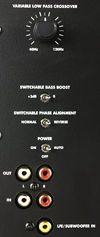Polk LSi Speaker System Page 2
 Many of my cohorts mock my like of Neil Young's Harvest DVD-Audio. Sure, it's mixed a little differently, but you can't beat the sound of 24/96 audio. Here's where the beauty of having switchable surround speakers really comes through. For the Blue Man Group disc and for movies, setting the LSiFXs in dipole mode worked great. For Harvest, it just didn't sound right, so I switched them to bipole mode with the simple two-position switch located below the rear-facing woofer. The sound snapped into place, and Ben Keith's slide guitar sounded positively creamy coming out of the left wall (don't ask; that's where it's mixed). Even in bipole mode, the LSiFX retains some aspects of diffusion, as no speaker aims directly at the listener in this setup. Instead, you get reflections, mostly off of the wall behind the listening position. I like this, as it made the room sound bigger; however, if you're a staunch monopole fanatic, a set of LSi9s in place of the LSiFXs might suit you better.
Many of my cohorts mock my like of Neil Young's Harvest DVD-Audio. Sure, it's mixed a little differently, but you can't beat the sound of 24/96 audio. Here's where the beauty of having switchable surround speakers really comes through. For the Blue Man Group disc and for movies, setting the LSiFXs in dipole mode worked great. For Harvest, it just didn't sound right, so I switched them to bipole mode with the simple two-position switch located below the rear-facing woofer. The sound snapped into place, and Ben Keith's slide guitar sounded positively creamy coming out of the left wall (don't ask; that's where it's mixed). Even in bipole mode, the LSiFX retains some aspects of diffusion, as no speaker aims directly at the listener in this setup. Instead, you get reflections, mostly off of the wall behind the listening position. I like this, as it made the room sound bigger; however, if you're a staunch monopole fanatic, a set of LSi9s in place of the LSiFXs might suit you better.
While the LSiC didn't sound quite as good as its LSi9 brother, it had no trouble keeping up with everything that I threw at it, from the deep PVC pipe sounds of the Blue Man Group disc to the haunting piano and vocals of Neil Young on "Man Needs a Maid." Like the LSi25 towers, the center is very directional. So, if you have a tall TV, you might need to prop up the back of the LSiC to point the speaker at the listening position.
Enough music; on to movies. Band of Brothers has many of the best war scenes put on film. Part seven (on disc four) shows an assault on the town of Foy. In chapter 6, the DTS track features gunfire, explosions, artillery, shouting, and music. In other words, it provides a solid speaker workout. The staccato gunfire was always distinct and never sounded harsh or fatiguing. The system's extra bass capability, so unpleasantly forceful earlier, was welcome here. You can crank it up, if you want, and rattle out your neighbors' fillings. Artillery fire shook the floor, and explosions rumbled forcefully.
Star Wars: Episode II—Attack of the Clones is quite the empty shell of a movie, but it does have several good demo scenes. Starting just before chapter 7, Anakin ignites his light saber, and its hum and crackle sounded warm, full, and distinct, thanks to the LSi25s' excellent tweeter/midrange combo. In the speeder chase seconds later, vehicles whizzed by in all directions on the Dolby EX track. All of the speakers blended together smoothly, and each one pulled its own weight to create a cohesive and downright huge soundfield.
I repeated all of the above tests with the LSi9s as the main speakers (no, I didn't put the LSi25s in the rear surround positions, as ridiculously fun as that may have been). As cool as the LSi25 is, the LSi9 is the real star of the show. It may not have the LSi25's visceral impact, but it has surprisingly good bass response for such a small speaker. The excellent tweeter that the rest of the system shares, plus the warm, inviting midrange and bass, add up to an all-around-excellent bookshelf speaker. Also, the fact that the LSi9s are truly plug and play, with no real setup required, is a major selling point over the LSi25s. If you have a smaller room, a pair of LSi9s and a sub would be excellent.
This brings me back to the beginning. I've said that this system is modular, and it definitely is. If you're a music fan with a smaller apartment, four LSi9s, the LSiC, and a sub (check out the new PSW808 over the PSW650) would be an excellent system. If you also like movies, swap the back pair of LSi9s for some LSiFXs. If you're somewhere in the middle, you may like the LSi25s in the front, the LSi9s in the back, and the LSiC in the center. From there, you can scale all the way up to the big-dog system that you see here, with copious amounts of bass and sound that surrounds from every angle. Even if you're not in the market for a full system, the LSi9s are worth checking out. Whether it's to replace two aging speakers or as a pair for the bedroom or den, the LSi9s offer excellent performance for the price. They excel no matter what role you put them in, which makes them modular in and of themselves, if not quite monolithic.
Highlights
• Terrific tweeter
• Lovely looks
• LSi9s are a 10
LSi25 Tower Speaker $3,000/pair
LSiC Center-Channel Speaker $580
LSiFX Surround Speaker $1,060/pair
LSi9 Bookshelf Speaker $1,040
PSW650 Subwoofer $770

- Log in or register to post comments





























































